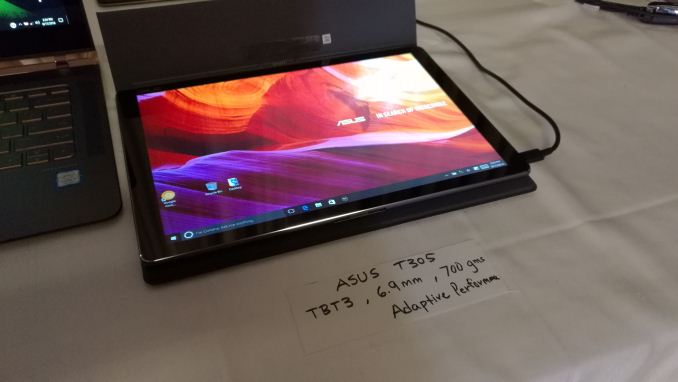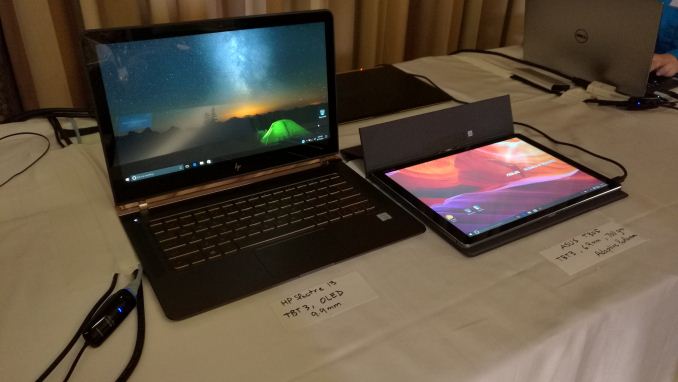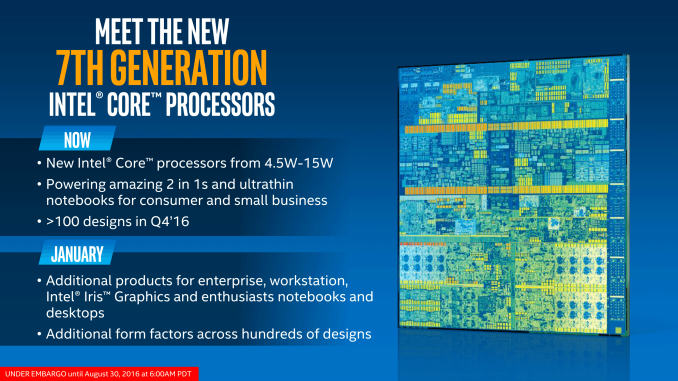Intel Announces 7th Gen Kaby Lake: 14nm PLUS, Six Notebook SKUs, Desktop coming in January
by Ganesh T S & Ian Cutress on August 30, 2016 9:00 AM EST- Posted in
- CPUs
- Intel
- 14nm
- Kaby Lake
- Gen 9
- Speed Shift
- Turbo Boost
Upcoming Hardware
Calling back to Computex, ASUS first announced a new Transformer device based on ‘Intel’s Next Generation’ processor. We knew it was Kaby Lake, but given the launch cycle for KBL it was understandable that the device was still a couple of months out and a work in process. At that point of the game the hardware specifications are typically squared away, and final touches are being made to the design ID as well as strong work on the software platform and ramping up the manufacturing aspect. We expect ASUS to launch their new Transformer products in due course.
At Intel’s pre-briefing for Kaby Lake, several systems were on display from HP all using the new processors. Specifications were not discussed, however devices with 4K panels and a variety of sizes were shown, including what looked like an upgraded Spectre, as well as a notebook with an OLED display.
This week is the annual IFA trade show in Berlin, which focuses on complete consumer electronics rather than components, as well as home appliances, IoT, and other things in-between. We have presentations and press events for a wide variety of companies including Acer, Samsung, Lenovo, Huawei, ZTE, and Sony, all of whom could be announcing something around Kaby Lake. (Qualcomm and AMD are also presenting at the show, but something tells me it isn’t to do with KBL.)
Explaining Why There’s No Desktop Parts Today
For the majority of enthusiasts, PC builders and gamers, questions about the time frame of the desktop processor launches, the benefits they bring and the pricing are swirling around the zeitgeist. Intel has confirmed with today’s launch that a wider array of Kaby Lake parts will be launched in January, including Iris graphics enabled processors, desktop parts, enterprise parts and workstation SKUs (vPro and Xeons, one would assume).
Despite the fact that this is still 14nm, one could assume that 14nm+ was focused on the small die parts first to improve yield before the larger desktop parts were produced, depending on how difficult the shift from 14 to 14+ actually was. There’s also the consideration about Intel’s product lines: Skylake on the desktop was only launched 12 months ago, and the next generation 10nm Intel product is - admittedly looking into a very foggy crystal ball - over a year away and will be mobile focused again as smaller dies are easier to make. Intel has to sufficiently space out its product stacks to ensure maximum profit, appease shareholders, but also give their customers a regular, expected update cycle. There’s a reason we don’t see the best product Intel could ever make on day one at unlimited expense.
Given that Intel has said that KBL is a similar IPC to SKL, it might be a bit worrying if desktop performance of the new parts is identical to the old ones, merely bumped up in frequency. Typically a small frequency bump mirrors a basic overclock; importantly however, if the pitch has been widened to allow a higher frequency, this could have a beneficial knock on effect for overclocking. Despite marketing efforts, Intel still limits overclocking to the two high-end SKUs, so how well Kaby Lake overclocks could prove important with desktop enthusiasts. If it overclocks better than Skylake, then we might be looking at the Skylake equivalent of the Haswell Refresh/Devil's Canyon. However if KBL offers the same OC frequency as SKL, and the same performance due to a similar IPC, then enthusiasts might not be interested. Ultimately Intel is going to market the new chips as a 3-5 year upgrade option for users still on Nehalem, Westmere and Sandy Bridge. This is ultimately where Intel believes most of the upgrade sales are coming from, rather than users jumping from Skylake.
The other factor is the motherboard side of the equation. We know that Kaby Lake on the desktop is to be accompanied by a new chipset launch as well, the 200-series, and typically if we were expecting a September launch then we would have seen motherboard examples at Computex. At the show, only MSI had an ‘unlabeled 200-series’ motherboard on show, which looked pretty identical to a Z170 product already on sale barring the design ID. We don’t yet know the benefits of the 200-series chipset over the 100-series line, and a release date in January would mean that motherboard manufacturers should now be in the final design steps for their major SKUs.
Saying ‘January’ as a launch date is quite vague. But, January has the annual CES event in Las Vegas during the first week after New Year, which is a common time to launch new CPUs after the holiday season finishes and people are ‘rested’.
Finally, it’s also worth noting that AMD is planning to enable widespread availability for their new Zen set of CPUs in Q1. So a January launch for desktop Kaby Lake could provide a more contested one for Intel. (If they also launch at CES, I need to start bulk ordering caffeine drips today. Goodbye sleep, it was nice knowing you. I may not be seen the rest of January.)
After all that, I’m pretty sure it’s pronounced Kay-bee Lake.














129 Comments
View All Comments
Alien959 - Wednesday, August 31, 2016 - link
So basicly this iteration of intel cpus opens a competitive opening for AMD. This is first time in 10 years that intel doesnt have some imrovment in ipc. Will have to wait for the benchmarks and reviews, but this is a chance for AMD. AMD needs and must deliver so we cosumers have some healty competition.Krysto - Wednesday, August 31, 2016 - link
> There are a couple of reasons for this - the one Intel discussed with us is that it comes down to performance and OEM requests. An i5 in a 4.5W form factor (or as high as 7W in cTDP Up) performs essentially on par with the KBL-U i5 parts, and OEM customers requested that the naming scheme change to reflect thatWhat a load of bull. More misleading marketing tricks from Intel once again.
The thing is Core i5 should've never been in the 4.5W range - when it was it just meant that it was either heavily throttled, or it would overheat.
So Intel created M5 to say that it's a lower-performance product that matches the 4.5W TDP better.
But NOW, Intel is renaming m5 to Core i5 to trick people into thinking they get similar performance as they do at higher TDPs. And saying "but Core i5 at 4.5W is the same as m5" - yeah but Core i5 (with a certain level of performance worthy of i5) NEVER WORKED WELL at 4.5W - that's why it needed higher TDP.
This is the same cr@p Intel pulled when it renamed mobile Atom chips to Celeron and Pentium.
WPX00 - Wednesday, August 31, 2016 - link
So the new MacBook Pro won't be here until January? Iris Graphics-equipped models only then? Or do you think Apple will announce a non-Iris equipped variant first this year, then more powerful models next year?SydneyBlue120d - Wednesday, August 31, 2016 - link
The long road to realtime 4320p60 HEVC Main 4:4:4 12 and HDMI 2.1 :DTunrip - Wednesday, August 31, 2016 - link
Page 2, "Working with Intel, they pushed through a new BIOS for the NUC that kept the OPI at PCIe 3.0 x4 speeds"I don't understand who "they" is in this context?
nonoverclock - Thursday, September 1, 2016 - link
IntelAllan_Hundeboll - Wednesday, August 31, 2016 - link
All the Intel news fact sheets and no conclusion makes this article look like an Intel advertisementMj@uk - Friday, September 2, 2016 - link
What are the base and max frecency of the i7-7500u @ the oem configrable tdp settings?ie low 7.5w, high 25w.
HollyDOL - Friday, September 2, 2016 - link
Wish they already released, yesterday my Sandy Bridge died (likely PSU+Motherboard), whould have prefered replacing it with Kaby lake + Z270 rather than Skylake + Z170.karma77police - Friday, September 2, 2016 - link
In another words a shit.